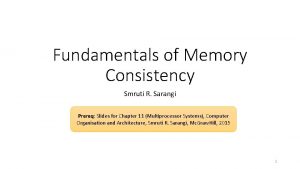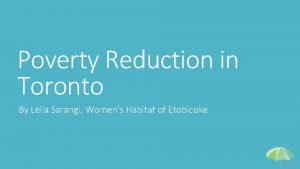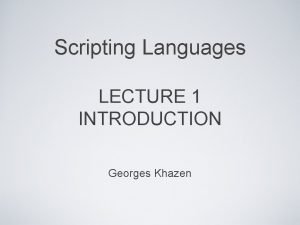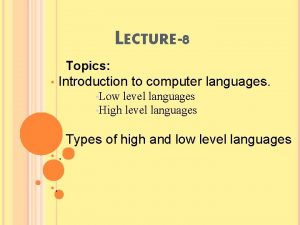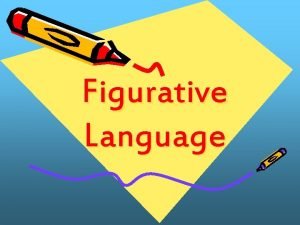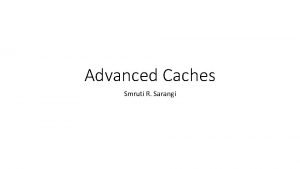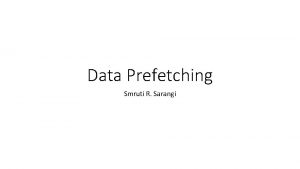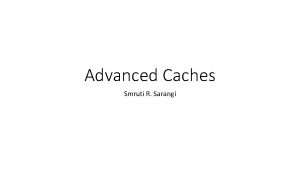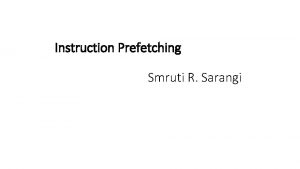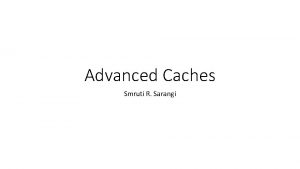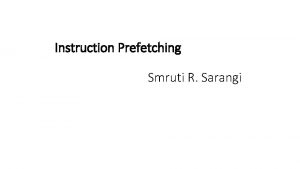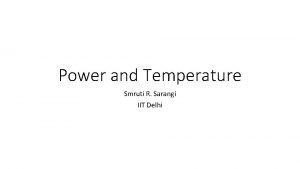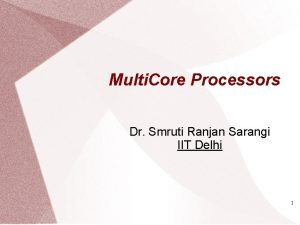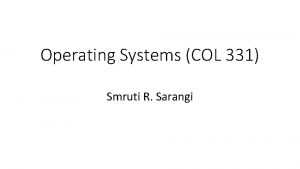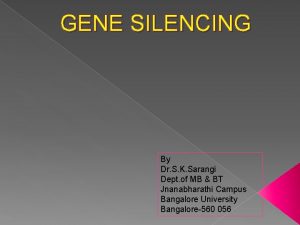The R Language 1 Dr Smruti R Sarangi


















![19 levels and table > levels (fac) [1] "Chinese" "Indian" "Russian" > table (fac) 19 levels and table > levels (fac) [1] "Chinese" "Indian" "Russian" > table (fac)](https://slidetodoc.com/presentation_image_h/864d739cbc1a2f46fe73c9f8342fa28d/image-19.jpg)







![27 Recycling Rule > cbind (1: 4, 1: 8) [, 1] [, 2] [1, 27 Recycling Rule > cbind (1: 4, 1: 8) [, 1] [, 2] [1,](https://slidetodoc.com/presentation_image_h/864d739cbc1a2f46fe73c9f8342fa28d/image-27.jpg)












![40 While loop > while (x[i] < 10) { + print (x[i]) + i 40 While loop > while (x[i] < 10) { + print (x[i]) + i](https://slidetodoc.com/presentation_image_h/864d739cbc1a2f46fe73c9f8342fa28d/image-40.jpg)

![42 Applying a Function > lapply (1: 2, cube) [[1]] [1] 1 [[2]] [1] 42 Applying a Function > lapply (1: 2, cube) [[1]] [1] 1 [[2]] [1]](https://slidetodoc.com/presentation_image_h/864d739cbc1a2f46fe73c9f8342fa28d/image-42.jpg)











- Slides: 53

The R Language 1 Dr. Smruti R. Sarangi and Ms. Hameedah Sultan Computer Science and Engineering IIT Delhi

2 Overview of R Language for statistical computing and data analysis Freely available under GPL v 2 Extensive library support Programming paradigms procedural functional object-oriented General matrix computation (similar to Matlab)

3 Running R Command Line Just type R The R command prompt comes up > . . . With a GUI R Studio R Commander

4 Outline Variables and Vectors Factors Arrays and Matrices Data Frames Functions and Conditionals Graphical Procedures

5 Normal Variables We can use <- as the assignment operator in R > x <- 4 (set x to 4) For printing the value of x > x [1] 4 OR, > print(x) [1] 4

6 A Numeric Vector Simplest data structure Numeric vector > v <- c(1, 2, 3) <- is the assignment operator c is the list concatenation operator To print the value, v Type : > v Output: [1] 1 2 3

7 A vector is a full fledged variable Let us do the following: > 1/v [1] 1. 0000000 0. 5000000 0. 3333333 > v + 2 [1] 3 4 5 We can treat a vector as a regular variable For example, we can have: > v 1 <- v / 2 > v 1 [1] 0. 5 1. 0 1. 5

8 Creating a vector with vectors > v <- c (1, 2, 3) > v [1] 1 2 3 > vnew <- c (v, 0, v) > vnew [1] 1 2 3 0 1 2 3 The c operator concatenates all the vectors

9 Functions on Vectors and Complex Numbers If v is a vector Here, are a few of the functions that take vectors as inputs: mean(v), max(v), sqrt(v), length(v), sum(v), prod(v), sort (v) (in ascending order) > x <- 1 + 1 i > y <- 1 i > x * y [1] -1+1 i

10 Generating Vectors Suppose we want a vector of the form: (1, 2, 3, . . . 100) We do not have to generate it manually. We can use the following commands: > v <- 1: 100 OR > v <- seq(1, 100) seq takes an additional argument, which is the difference between consecutive numbers: seq (1, 100, 10) gives (1, 11, 21, 31. . . , 91) rep (2, 5) generates a vector (2, 2, 2)

11 Boolean Variables and Vectors R recognizes the constants: TRUE, FALSE TRUE corresponds to 1 FALSE corresponds to 0 We can define a vector of the form: v <- c (TRUE, FALSE, TRUE) We can also define a logical vector Can be created with logical operators: <, <=, >=, ==, !=, & and I > v <- 1: 9 > 5 > v [1] FALSE FALSE TRUE

12 String Vectors Similarly, we can have a vector of strings > vec <- c (“f 1”, “f 2”, “f 3”) > vec [1] "f 1" "f 2" "f 3“ The paste function can be used to create a vector of strings paste(1: 3, 3: 5, sep="*") [1] "1*3" "2*4" "3*5" It takes two vectors of the same length, and an optional argument, sep. The ith element of the result string, contains the ith elements of both the arguments, separated by the string specified by sep.

13 Outline Variables and Vectors Factors Arrays and Matrices Data Frames Functions and Conditionals Graphical Procedures

14 Factors Factor Definition: A vector used to specify a grouping (classification) of objects in other vectors. Consider the following problem: We have a vector of the type of the Nationality of students, and a vector of their marks in a given subject. AIM: Find the average scores per nationality.

Graphical View of the Problem 15 Indian Chinese Russian Factor Indian 6 Chinese 8 Indian 7 Chinese 9 Indian 8 Russian 10 Nationality Marks

16 Code # character starts a comment > nationalities <- c ("Indian", "Chinese", "Indian", "Russian") # create a factor > marks <- c (6, 8, 7, 9, 8, 10) > fac <- factor(nationalities) > fac [1] Indian Chinese Indian Russian Levels: Chinese Indian Russian The levels of a factor indicate the categories

17 Code - II Now let us apply the factor to the marks vector > results <- tapply (marks, fac, mean) Works on each element of the list factor List of marks compute the mean in each category

18 Time for the results > results Chinese Indian Russian 8. 5 7. 0 10. 0 Let us now apply the sum function > tapply (marks, fac, sum) Chinese Indian Russian 17 21 10
![19 levels and table levels fac 1 Chinese Indian Russian table fac 19 levels and table > levels (fac) [1] "Chinese" "Indian" "Russian" > table (fac)](https://slidetodoc.com/presentation_image_h/864d739cbc1a2f46fe73c9f8342fa28d/image-19.jpg)
19 levels and table > levels (fac) [1] "Chinese" "Indian" "Russian" > table (fac) fac Chinese Indian Russian 2 3 1 Let us assume that the factor is fac is [1] Indian Chinese Indian Russian Levels: Chinese Indian Russian levels returns a vector containing all the unique labels table returns a special kind of array that contains the counts of entries for each label

20 Outline Variables and Vectors Factors Arrays and Matrices Data Frames Functions and Conditionals Graphical Procedures

21 Arrays and Matrices Generic array function Creates an array. Takes two arguments: data_vector of values dimension_vector Example: > array (1: 10, c(2, 5)) [, 1 [, 2] [, 3] [, 4] [, 5] [1, ] 1 3 5 7 9 [2, ] 2 4 6 8 10 The numbers are laid out in column major order. Count from 1, Not 0

22 Other ways to make arrays Take a vector, and assign it dimensions > v <- c (1, 2, 3, 4) > dim(v) <- c(2, 2) > v [, 1] [, 2] [1, ] 1 3 [2, ] 2 4

23 Arrays are Created in Column Major Order > v <- 1: 8 > dim(v) <- c(2, 2, 2) > v , , 1 [, 1] [, 2] [1, ] 1 3 [2, ] 2 4 , , 2 [, 1] [, 2] [1, ] 5 7 [2, ] 6 8 > v[2, 1, 2] [1] 6 Start from the last index Array elements are accessed by specifying their index (within square brackets)

24 The matrix command A matrix is a 2 -D array There is a fast method of creating a matrix Use the matrix (data, dim 1, dim 2) command Example: > matrix(1: 4, 2, 2) [, 1] [, 2] [1, ] 1 3 [2, ] 2 4

25 cbind and rbind mat 1 mat 2 mat 1 cbind mat 1 mat 2 rbind mat 2

26 Problem: set the diagonal elements of a matrix to 0 > mat <- matrix(1: 16, 4, 4) > mat [, 1] [, 2] [, 3] [, 4] [1, ] 1 5 9 13 [2, ] 2 6 10 14 [3, ] 3 7 11 15 [4, ] 4 8 12 16 > indices <- cbind (1: 4, 1: 4) > mat[indices] <- 0 > mat [, 1] [, 2] [, 3] [, 4] [1, ] 0 5 9 13 [2, ] 2 0 10 14 [3, ] 3 7 0 15 [4, ] 4 8 12 0
![27 Recycling Rule cbind 1 4 1 8 1 2 1 27 Recycling Rule > cbind (1: 4, 1: 8) [, 1] [, 2] [1,](https://slidetodoc.com/presentation_image_h/864d739cbc1a2f46fe73c9f8342fa28d/image-27.jpg)
27 Recycling Rule > cbind (1: 4, 1: 8) [, 1] [, 2] [1, ] 1 1 [2, ] 2 2 [3, ] 3 3 [4, ] 4 4 [5, ] 1 5 [6, ] 2 6 [7, ] 3 7 [8, ] 4 8 The smaller structure is replicated to match the length of the longer structure Note that the size of the longer structure has to be a multiple of the size of the smaller structure.

Matrix Operations 28 A * B is a normal element-by-element product A %*% B is a matrix product Equation solution: solve (A, b) (for equations of the form Ax = b) solve (A) returns the inverse of the matrix > A <- matrix (1: 4, 2, 2) > b <- 5: 6 > solve (A, b) [1] -1 2 > solve(A) %*% b [, 1] [1, ] -1 [2, ] 2 Solve an equation of the form: Ax = b A-1 * b = x

29 Additional Features nrow (mat) Number of rows in the matrix ncol (mat) Number of columns in the matrix Feature Function Eigen Values eigen Singular Value Decomposition svd Least Squares Fitting lsfit QR decomposition qr

30 Outline Variables and Vectors Factors Arrays and Matrices Data Frames Functions and Conditionals Graphical Procedures

31 Lists and Data Frames A list is a heterogeneous data structure It can contain data belonging to all kinds of types Example: > lst <- list (“one”, 1, TRUE) Elements can be lists, arrays, factors, and normal variables The components are always numbered They are accessed as follows: lst[[1]], lst[[2]], lst[[3]] [[. . . ]] is the operator for accessing an element in a list

32 Named Components Lists can also have named components lst <- list(name=“Sofia”, age=29, marks=33. 7) The three components are: lst$name, lst$age, lst$marks We can also use lst [[“name”]], lst[[“age”]], lst [[“marks”]]

33 Data Frames rows columns Data Frame It is a table in R > entries <- c(“cars”, “trucks”, “bikes”) > price <- c (8, 10, 5) > num <- c (1, 2, 3) > df <- data. frame(entries, price, num) > df entries price num 1 cars 8 1 2 trucks 10 2 3 bikes 5 3

34 Accessing an Element Can be accessed as a regular array, or as a list > df[1, 2] [1] 8 Row names, i. e. character values > df[2, ] entries price num 2 trucks 10 2 > df$price [1] 8 10 5 Summary shows a summary of each variable in the data frame > summary(df) entries price num bikes : 1 Min. : 5. 000 Min. : 1. 0 cars : 1 1 st Qu. : 6. 500 1 st Qu. : 1. 5 trucks: 1 Median : 8. 000 Median : 2. 0 Mean : 7. 667 Mean : 2. 0 3 rd Qu. : 9. 000 3 rd Qu. : 2. 5 Max. : 10. 000 Max. : 3. 0 Feature Function Show first 6 rows of df head(df) List objects ls() Remove variables x & y rm(x, y) from data frame Sort df on variable x [order(df$x), ]

35 Operations on Data Frames A data frame can be sorted on the values of a variable, filtered using values of a variable, and grouped by a variable. Eg. Filter rows where entries = “cars” > df[df$entries == "cars", ] entries price num 1 cars 8 1 Group by entries > aggregate(df, by = list(entries), mean) Group. 1 entries price num 1 bikes NA 5 3 2 cars NA 8 1 3 trucks NA 10 2

36 Reading Data from Files Reads in a data frame from a file Steps: Store the data frame in a file Read it in > df <- read. table (“<filename>”) Access the data frame

37 Outline Variables and Vectors Factors Arrays and Matrices Data Frames Functions and Conditionals Graphical Procedures

38 Grouping, Loops, Conditional Execution R does have support for regular if statements, while loops, and other conditionals if statement if (condition) statement 1 else statement 2. Use {} for creating grouped statements The condition should evaluate to a single variable (not a vector) Example: > x <- 3 > if (x > 0) x <- x+ 3 else x <- x + 6 > x [1] 6

39 For loop for (var in expr 1) {. . . . } Example: > for (v in 1: 10) print (v) [1] 1 [1] 2 [1] 3 [1] 4 [1] 5 [1] 6 [1] 7 [1] 8 [1] 9 [1] 10
![40 While loop while xi 10 print xi i 40 While loop > while (x[i] < 10) { + print (x[i]) + i](https://slidetodoc.com/presentation_image_h/864d739cbc1a2f46fe73c9f8342fa28d/image-40.jpg)
40 While loop > while (x[i] < 10) { + print (x[i]) + i <- i + 1 + } [1] 1 [1] 2 [1] 3 [1] 4 [1] 5 [1] 6 [1] 7 [1] 8 [1] 9 Use the break statement to exit a loop

41 Writing one’s own functions > cube <- function (x) { + x * x + } > cube(4) [1] 64 A function takes a list of arguments within (. . . ) To return a value, just print the expression (without assignment statements) Function calling convention similar to C
![42 Applying a Function lapply 1 2 cube 1 1 1 2 1 42 Applying a Function > lapply (1: 2, cube) [[1]] [1] 1 [[2]] [1]](https://slidetodoc.com/presentation_image_h/864d739cbc1a2f46fe73c9f8342fa28d/image-42.jpg)
42 Applying a Function > lapply (1: 2, cube) [[1]] [1] 1 [[2]] [1] 8 Apply the cube function to a vector Applies the function to each and every argument sapply returns a list > sapply (1: 3, cube) [1] 1 8 27

43 Named arguments > fun <- function (x=4, y=3) { x - y } > fun() [1] 1 > fun (4, 3) [1] 1 > fun (y=4, x=3) [1] -1 Possible to specify default values in the function declaration If a variable is not specified, the default value is used We can also specify the values of the variables by the name of the argument (last line)

44 Scoping in R > deposit <- function (amt) balance + amt > withdraw <- function (amt) balance - amt > balance <- withdraw(10) > balance <- deposit (20) > balance [1] 110 Scope of variables in R Function arguments (valid only inside the function) Local variables (valid only inside the function) Global variables (balance)

45 Functional Programming: Closures > exponent <- function (n) { + power <- function (x) { + x ** n + } > square <- exponent(2) > square(4) [1] 16 A function with pre-specified data is called a closure exponent returns a function power (with n = 2)

source 46 http: //adv-r. had. co. nz/Functional-programming. html Example: Numerical Integration > composite <- function(f, a, b, n = 10, rule) { function passed as an argument area <- 0 + points <- seq(a, b, length = n + 1) + + area <- 0 + for (i in seq_len(n)) { + area <- area + rule(f, points[i], points[i + 1]) + } + + area + } > midpoint <- function(f, a, b) { + (b - a) * f((a + b) / 2) + } > composite(sin, 0, pi, n = 1000, rule = midpoint) [1] 2. 00000 Function for numerical integration Midpoint rule

47 Outline Variables and Vectors Factors Arrays and Matrices Data Frames Functions and Conditionals Graphical Procedures

48 Plotting a Function A basic 2 D plot: vec 1 <-cube(seq(1, 100, 10)) vec 2 <-cube(seq(5, 100, 10)) Plot type (overplotted) plot(vec 1, type="o", col="blue“, ylim=c(0, 3 e 5)) title(main=“Plot of Cubes", col. main="red") To add a line to the same plot: lines(vec 2, type=“o", lty = 2, pch = 22, col=“red“) To add a legend: Line type: dashed Marker type: square legend(1, max(vec 1), c(“vec 1", “vec 2"), cex=0. 8, col=c("blue", "red"), pch=21: 22, lty=1: 2)

49 Plotting: Linear Regression library("MASS") data(cats) # load data plot(cats$Bwt, cats$Hwt) # scatter plot of cats body weight vs heart rate M <- lm(formula = cats$Hwt ~ cats$Bwt, data=cats) # fit a linear model regmodel <- predict(M) # predict values using this model plot(cats$Bwt, cats$Hwt, pch = 16, cex = 1. 3, col = "blue", main = "Heart rate plotted against body weight of cats", xlab = "Body weight", ylab = "Heart rate") # scatter plot abline(M) # plot the regression line

50 Creating 3 -D plots Packages plot 3 D, ggplot 2 contain useful 3 D plotting options plot 3 d, scatter 3 d, surf 3 d, persp 3 d are some of the commonly used plots. plot 3 d is from package rgl. It allows creating interactive 3 D plots that can be rotated using the mouse. plot 3 d(x, y, z, col="red", size=3)

51 Creating 3 -D plots: surf 3 D Surf 3 d (package: plot 3 D) allows us to create surface plots like the one shown below: #source: http: //blog. revolutionanalytics. com/2014/02/3 dplots-in-r. html library ('ggplot 2') library(plot 3 D) par(mar = c(2, 2, 2, 2)) par(mfrow = c(1, 1)) R <- 3; r <- 2 x <- seq(0, 2*pi, length. out=50) y <- seq(0, pi, length. out=50) M <- mesh(x, y) alpha <- M$x; beta <- M$y surf 3 D(x = (R + r*cos(alpha)) * cos(beta), y = (R + r*cos(alpha)) * sin(beta), z = r * sin(alpha), colkey=FALSE, bty="b 2", main="Half of a Torus")

52 Creating 3 -D plots: persp 3 d(package: plot 3 D) allows us to create surface plots like the one shown below: xdim <- 16 newmap <- array(0, dim=c(xdim, xdim)) newmap <- rnorm(256, 1, . 2) jet. colors <- color. Ramp. Palette( c("yellow", "red") ) pal <- jet. colors(100) col. ind <- cut(newmap, 100) # colour indices of each point persp 3 d(seq(1: xdim), newmap, shade=TRUE, type="wire", col=pal[col. ind], xlab="", ylab="", zlab="", cex. axis=1. 5, xtics="", aspect=2, zlim=c(0, 5))

53
 Smruti r. sarangi
Smruti r. sarangi Smruti sarangi
Smruti sarangi Smruti ranjan sarangi
Smruti ranjan sarangi Leila sarangi
Leila sarangi Tokoh musik india
Tokoh musik india Hát kết hợp bộ gõ cơ thể
Hát kết hợp bộ gõ cơ thể Slidetodoc
Slidetodoc Bổ thể
Bổ thể Tỉ lệ cơ thể trẻ em
Tỉ lệ cơ thể trẻ em Voi kéo gỗ như thế nào
Voi kéo gỗ như thế nào Tư thế worm breton
Tư thế worm breton Hát lên người ơi
Hát lên người ơi Kể tên các môn thể thao
Kể tên các môn thể thao Thế nào là hệ số cao nhất
Thế nào là hệ số cao nhất Các châu lục và đại dương trên thế giới
Các châu lục và đại dương trên thế giới Công của trọng lực
Công của trọng lực Trời xanh đây là của chúng ta thể thơ
Trời xanh đây là của chúng ta thể thơ Mật thư anh em như thể tay chân
Mật thư anh em như thể tay chân Phép trừ bù
Phép trừ bù độ dài liên kết
độ dài liên kết Các châu lục và đại dương trên thế giới
Các châu lục và đại dương trên thế giới Thơ thất ngôn tứ tuyệt đường luật
Thơ thất ngôn tứ tuyệt đường luật Quá trình desamine hóa có thể tạo ra
Quá trình desamine hóa có thể tạo ra Một số thể thơ truyền thống
Một số thể thơ truyền thống Bàn tay mà dây bẩn
Bàn tay mà dây bẩn Vẽ hình chiếu vuông góc của vật thể sau
Vẽ hình chiếu vuông góc của vật thể sau Thế nào là sự mỏi cơ
Thế nào là sự mỏi cơ đặc điểm cơ thể của người tối cổ
đặc điểm cơ thể của người tối cổ Ví dụ giọng cùng tên
Ví dụ giọng cùng tên Vẽ hình chiếu đứng bằng cạnh của vật thể
Vẽ hình chiếu đứng bằng cạnh của vật thể Tia chieu sa te
Tia chieu sa te Thẻ vin
Thẻ vin đại từ thay thế
đại từ thay thế điện thế nghỉ
điện thế nghỉ Tư thế ngồi viết
Tư thế ngồi viết Diễn thế sinh thái là
Diễn thế sinh thái là Các loại đột biến cấu trúc nhiễm sắc thể
Các loại đột biến cấu trúc nhiễm sắc thể Số nguyên là gì
Số nguyên là gì Tư thế ngồi viết
Tư thế ngồi viết Lời thề hippocrates
Lời thề hippocrates Thiếu nhi thế giới liên hoan
Thiếu nhi thế giới liên hoan ưu thế lai là gì
ưu thế lai là gì Sự nuôi và dạy con của hổ
Sự nuôi và dạy con của hổ Khi nào hổ con có thể sống độc lập
Khi nào hổ con có thể sống độc lập Sơ đồ cơ thể người
Sơ đồ cơ thể người Từ ngữ thể hiện lòng nhân hậu
Từ ngữ thể hiện lòng nhân hậu Thế nào là mạng điện lắp đặt kiểu nổi
Thế nào là mạng điện lắp đặt kiểu nổi Language acquisition vs language learning
Language acquisition vs language learning Difference between second language and foreign language
Difference between second language and foreign language Strongly typed scripting language
Strongly typed scripting language Difference between standard language and home language
Difference between standard language and home language Disadvantage of assembly language
Disadvantage of assembly language Hardware description language vs programming language
Hardware description language vs programming language Figurative vs literal language
Figurative vs literal language

